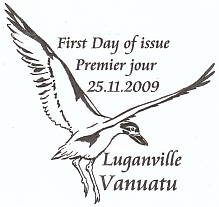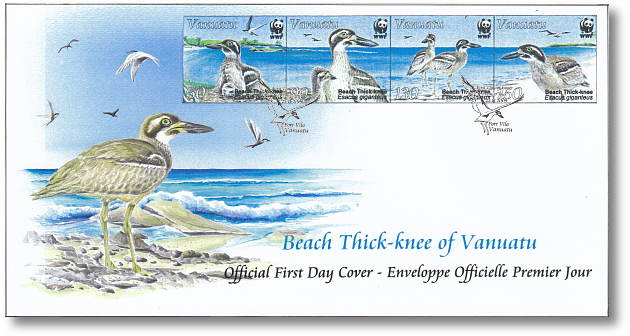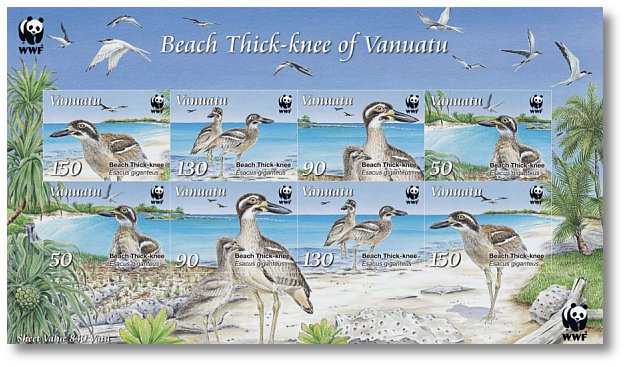Beach Thick Knee
-
Denominations :50, 90, 130 and 150 vatu. M/S 840 vatu
-
Designer :Jean Richard Lisiak, Paris, France
-
Mini Sheet size :210.0 mm x 105.0 mm, horizontal
-
Paper :104gsm Litho Gummed stamp paper
-
Perforation Gauge :13.2 X 2
-
Period of Sale :25 November 2009 for a period of 2 years
-
Printer :Wyatt and Wilson, Christchurch, New Zealand
-
Process :Offset lithography
-
Stamp Size :42.27 mm x 30.23 mm, horizontal (2 sets within miniature sheet)
Description

Vanuatu Post is proud to be endorsed by WWF in releasing a stamp issue featuring the Beach Thick-knee Esacus giganteus also known as the Beach Stone-curlew, is a large, ground-dwelling bird that has a widespread range around coasts from the Andaman Islands, India, Myanmar, islands off peninsular Thailand, and Peninsular Malaysia through Indonesia, Brunei, the Philippines, Papua New Guinea, the Solomon Islands, Vanuatu, New Caledonia and Australia.
The names Thick-knee and Stone- curlew are both in common use. The term Stone-curlew owes its origin to the broad similarities with true curlews. Thick-knee refers to the prominent joints in the long yellow or greenish legs and apparently originated with a name coined in 1776 for the Thick-kneed Bustard.
The Beach Thick-knee resides around undisturbed open beaches, exposed reefs, and tidal sand or mudflats over a large area. Beaches associated with estuaries and mangroves are particularly favoured. They are less nocturnal than most others in the species, and can sometimes be seen foraging by daylight, moving slowly and deliberately, with occasional short runs. They tend to forage mainly in the inter-tidal zone, on crustaceans, insects and other invertebrates. Larger species will also take lizards and even small mammals. 
They are medium to large waders with strong black or yellow black bills, black-and-white facial markings and large yellow eyes which give them a reptilian appearance. They are also characterised by their loud wailing songs, which are reminiscent of true curlews.
Adults are sedentary, although the species has a tendency for wide-ranging vagrancy. The female lays a single egg in a scrape in the sand laid just above the high tide line at the landward edge of the beach, often using the same area repeatedly. As the nest is vulnerable to predation and human disturbance, the Beach Thick-knee tends to be wary and fly off into the distance ahead of the observer, employing slow, rather stiff wingbeats. The Beach Thick-knee appears to be threatened by this extensive human disturbance of beach habitats in many areas and is also thought to be sensitive to predation by introduced mammals. The resultant small population is therefore classified as near threatened on the International Union for the Conservation of Nature and Natural Resources (IUCN) Red List of Threatened Species.


